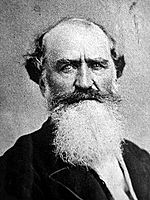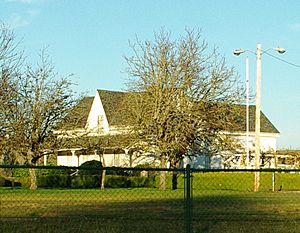Robert Newell (politician) facts for kids
Quick facts for kids
Robert Newell
|
|
|---|---|
 |
|
| Speaker of the Provisional Legislature of Oregon | |
| In office December 2, 1845 – December 10, 1845 |
|
| Preceded by | Morton M. McCarver |
| Succeeded by | Henry A. G. Lee |
| In office December 7, 1847 – December 28, 1847 |
|
| Preceded by | Asa Lovejoy |
| Succeeded by | Ralph Wilcox |
| Member of the Provisional Legislature of Oregon | |
| In office June 27, 1843 – December 28, 1847 |
|
| Constituency | Champoick District |
| Member of the Oregon House of Representatives | |
| In office September 10, 1860 – October 19, 1860 |
|
| Constituency | Marion County |
| Personal details | |
| Born | March 30, 1807 Zanesville, Ohio |
| Died | November 24, 1869 (aged 62) Lapwai, Idaho |
| Political party | Democrat |
| Spouses | Kitty Newell Rebecca Newman Mrs. Ward |
| Relations | Joseph L. Meek |
| Occupation | fur trader |
Robert "Doc" Newell (born March 30, 1807 – died November 24, 1869) was an important person in the early history of the Oregon Country. He was a fur trapper and a politician. He also became known as a "frontier doctor" because he was good at helping people who were sick or hurt, even though he wasn't a trained doctor.
Newell was born in Ohio. He played a big part in setting up the first government in Oregon. Later, he served in the state's law-making body. You can visit the Newell House Museum today. It's a rebuilt version of his old home in Champoeg. This house is a special historical site.
Contents
Early Adventures and the "Doc" Nickname
Robert Newell was born in Zanesville, Ohio, on March 30, 1807. In 1829, when he was 22, he joined a group of men led by William Sublette. Their goal was to trap beavers for their fur. Other famous people like Joseph L. Meek and Jedediah Smith were also in this group.
Newell spent the 1830s trapping furs in the wild lands west of the Rocky Mountains. In 1833, he married a Nez Perce woman named Kitty. During his time as a "mountain man", he learned a lot about basic medicine. He became very good at helping people with injuries or illnesses. Even though he never went to medical school, people started calling him "Doctor" or "Doc" Newell. This nickname stuck with him for the rest of his life.
In 1840, Newell and his brother-in-law, Joseph Meek, decided to move to the Oregon Country for good. They arrived on the Tualatin Plains on Christmas Day. They brought two cows with them. This journey was a big deal! It was the first time a wagon had traveled all the way from Fort Hall to the Columbia River along the Oregon Trail. The next year, they were the first to bring a wagon into the Willamette Valley.
Building Oregon's Future
In 1842, Robert Newell helped start the Oregon Lyceum in Oregon City, Oregon. This was a place for learning and discussion. Later, he became the leader of the Oregon Printing Association. This group grew out of the Lyceum and started the first newspaper west of the Rocky Mountains. It was called the Oregon Spectator.
On May 2, 1843, settlers had an important meeting at Champoeg. Newell voted to create a temporary government for the region. The vote was very close, 52 to 50, but it passed! This led to the creation of the Provisional Legislature of Oregon. Newell served in this government from 1843 until 1849. He even served as the Speaker of the group in 1847.
Newell's first wife, Kitty, passed away in 1845. She was buried in Champoeg. You can still visit her gravesite today at the Champoeg State Heritage Area. In 1846, he married Rebecca Newman.
After a sad event called the Whitman massacre, a conflict known as the Cayuse War began. Newell was chosen to be a peace commissioner. On March 7, 1848, he successfully worked to keep the Nez Perce tribe from joining the war. He was then appointed as an Indian agent for tribes south of the Columbia River.
In 1849, Newell traveled to California to search for gold during the California Gold Rush. He returned to Oregon in 1850. There, he helped plan the town of Champoeg with Andre Longtain. From 1855 to 1856, he commanded a group of army scouts during the Rogue River Wars.
In 1860, after Oregon became a state in 1859, Newell was elected to the Oregon House of Representatives. He represented Marion County as a Democrat. In 1861, a huge flood on the Willamette River destroyed most of Champoeg. However, Newell's house was on higher ground and survived. He helped many flood victims, which almost caused him to lose all his money.
Later Life and Legacy
After the 1861 flood, Newell moved to Lapwai, Idaho. From 1862 to 1868, he worked there as an interpreter and commissioner for the army. His second wife died in 1867. In 1869, he married for a third time to Mrs. Ward.
In 1868, he traveled to Washington, D.C., with several Native American chiefs. They wanted to change some treaties between the United States and the tribes. That same year, President Andrew Johnson appointed him as an Indian agent.
Robert Newell passed away from a heart attack on November 24, 1869, in Lapwai, Idaho. He had five children with his first wife and eleven with his second wife. After he died, several Native American tribes gave him 5 acres (20,000 m2) of land in what is now Lewiston. The official document for this land is dated June 9, 1871.
The Newell House Museum
Today, you can visit a special house in Champoeg State Heritage Area. It's a copy of Robert Newell's house from 1852, built in a style called Carpenter Gothic. The Oregon State Society of the Daughters of the American Revolution runs it as a house museum. They rebuilt the house for Oregon's 100th birthday in 1959, as the original had become very old and damaged. The rebuilt house still has some of the original parts, like some of the windows. It helps us remember Robert Newell and his important role in Oregon's history.


